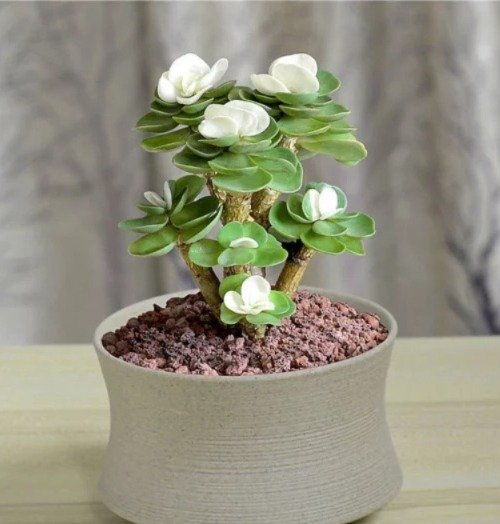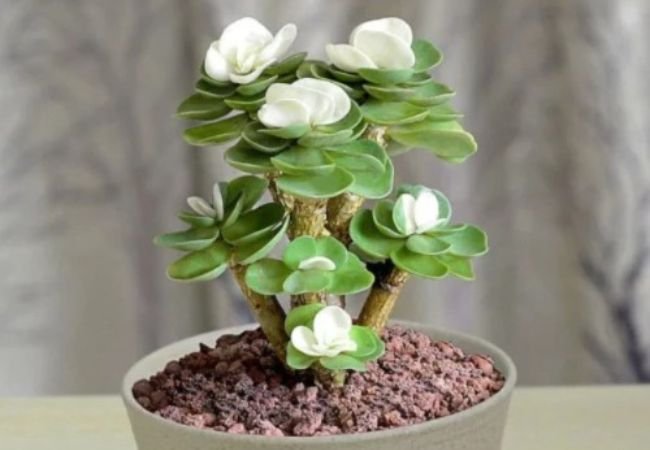Learn how to care for Petal Leaf Succulent with our complete guide. Discover essential tips for watering, light, soil, and more to keep your plant thriving.
Are you looking to add a unique and beautiful plant to your collection? The Petal Leaf Succulent might be just what you need. This stunning plant, also known as Graptopetalum, is loved for its rosette-shaped leaves that look like delicate petals. In this guide, we’ll walk you through everything you need to know about caring for Petal Leaf Succulents. From watering to propagation, we’ve got you covered. Let’s dive in and learn how to keep your Petal Leaf Succulent happy and healthy!
Here’s a short information chart:
| Attribute | Details |
|---|---|
| Botanical Name | Portulaca molokiniensis |
| Common Name | Petal Leaf Succulent, Molokini purslane, ‘Ihi’ |
| Plant Type | Perennial succulent |
| Zones | 10-11 (USDA) |
| Sun Exposure | Full sun to partial shade |
| Soil Type | Sandy, well-draining |
| Watering | Low, drought-tolerant |
| Growth Habit | Spreading, trailing |
| Height/Spread | Up to 6 inches tall, spreads up to 2 feet |
| Special Features | Drought-tolerant, salt-tolerant |
What is a Petal Leaf Succulent?

Petal Leaf Succulents belong to the genus Graptopetalum. They’re part of the Crassulaceae family, which includes many popular succulents. What makes these plants special is their rosette shape. The leaves grow in a circular pattern, looking a lot like flower petals. This is where they get their common name.
These plants come from Mexico and nearby areas. They’re used to warm, dry climates. In the wild, they often grow on rocky slopes. This background helps us understand what they need to thrive in our homes.
According to the University of Wisconsin-Madison, succulents like Petal Leaf are great for beginners. They’re tough plants that can handle a bit of neglect.
Light Requirements for Petal Leaf Succulents
Petal Leaf Succulents love light. In fact, they need a lot of it to stay healthy and keep their pretty colors. Here’s what you need to know about lighting:
- Bright, indirect light is best. A spot near a sunny window is perfect.
- These plants can handle some direct sunlight, especially in the morning. But too much harsh afternoon sun can burn the leaves.
- If your plant starts to stretch or “reach” towards the light, it’s not getting enough. This is called etiolation.
- In low light, Petal Leaf Succulents will lose their bright colors. They might turn green or pale.
- If you’re growing your plant outdoors, give it some shade during the hottest part of the day.
- Rotate your plant every few weeks. This helps it grow evenly on all sides.
Remember, every home is different. Watch your plant and adjust its spot if needed. The right light will keep your Petal Leaf Succulent looking its best.
Watering Your Petal Leaf Succulent
Watering is one of the trickiest parts of succulent care. Petal Leaf Succulents, like most succulents, don’t need much water. In fact, too much water can harm them. Here’s how to water the right way:
- Water deeply but infrequently. This mimics the rain patterns in their native habitat.
- Let the soil dry out completely between waterings. Stick your finger about an inch into the soil. If it’s dry, it’s time to water.
- In spring and summer (the growing season), you might water every 7-10 days.
- In fall and winter, cut back on watering. Once every 2-3 weeks might be enough.
- Always use pots with drainage holes. This lets excess water escape.
- Water the soil, not the leaves. Wet leaves can lead to rot.
- If the leaves start to look wrinkled or feel soft, your plant needs water.
The University of California warns that overwatering is the most common killer of succulents. When in doubt, it’s better to underwater than overwater.
Soil and Potting for Petal Leaf Succulents
The right soil is crucial for Petal Leaf Succulents. These plants need soil that drains quickly. Here’s what you should know:
- Use a well-draining cactus or succulent mix. You can buy this at most garden stores.
- If you want to make your own mix, combine regular potting soil with coarse sand and perlite.
- Avoid regular potting soil on its own. It holds too much water for succulents.
- When potting, choose a container with drainage holes. This is super important!
- Terracotta pots are great for succulents. They let water evaporate through the sides.
- Repot your Petal Leaf Succulent every 2-3 years, or when it outgrows its pot.
- When repotting, gently remove old soil from the roots. Be careful not to damage them.
According to Colorado State University, a good soil mix for succulents should be about 2/3 inorganic material (like sand or perlite) and 1/3 organic material (like potting soil).
Fertilizing Your Petal Leaf Succulent
Petal Leaf Succulents don’t need much fertilizer. They’re used to growing in poor soil. But a little food can help them grow stronger and produce more leaves. Here’s how to fertilize:
- Use a balanced, water-soluble fertilizer made for cacti and succulents.
- Fertilize only during the growing season (spring and summer).
- Dilute the fertilizer to half the strength recommended on the package.
- Feed your plant once a month during the growing season.
- Stop fertilizing in fall and winter when the plant’s growth slows down.
- If you see salt buildup on the soil (it looks like a white crust), flush the soil with plain water.
Remember, it’s easy to over-fertilize succulents. When in doubt, use less fertilizer. Too much can harm your plant.
Temperature and Humidity for Petal Leaf Succulents
Petal Leaf Succulents like conditions similar to their native habitat. They prefer warm, dry environments. Here’s what you need to know:
- These plants do best in temperatures between 60-80°F (15-27°C).
- They can handle brief periods of cold, but prolonged exposure to temperatures below 50°F (10°C) can damage them.
- Protect your plant from frost if you grow it outdoors.
- Petal Leaf Succulents prefer low humidity. They don’t need extra moisture in the air.
- If your home is very humid, make sure your plant has good air circulation.
- Avoid placing your plant near air conditioners or heaters. Sudden temperature changes can stress it.
The United States Department of Agriculture notes that many Graptopetalum species are hardy in USDA zones 9-11. This means they can survive outdoors year-round in warm climates.
Pruning and Maintenance
Petal Leaf Succulents don’t need much pruning. But a little maintenance can keep them looking their best. Here’s what you can do:
- Remove dead or dying leaves regularly. This keeps your plant tidy and prevents pests.
- If your plant gets too tall or leggy, you can cut off the top. This will encourage bushier growth.
- Always use clean, sharp scissors or pruning shears.
- Dust the leaves gently with a soft brush or cloth. This helps the plant absorb more light.
- Check for pests like mealybugs or spider mites. If you spot any, treat them quickly with insecticidal soap.
- Rotate your plant every few weeks for even growth.
Remember, less is often more when it comes to succulents. They don’t need a lot of fussing to thrive.
Propagating Petal Leaf Succulents
One of the best things about Petal Leaf Succulents is how easy they are to propagate. You can grow new plants from leaves or stem cuttings. Here’s how:
Leaf Propagation:
- Gently twist a healthy leaf off the stem. Make sure you get the whole leaf, including the base.
- Let the leaf callus over for a few days. This means letting the cut end dry out and heal.
- Place the leaf on top of well-draining soil.
- Mist the soil lightly every few days.
- In a few weeks, you should see tiny roots and a new rosette forming at the base of the leaf.
Stem Cutting Propagation:
- Cut a stem with a clean, sharp knife. Make sure your cutting has several leaves.
- Remove the lower leaves, leaving a bare stem.
- Let the cutting dry out for a day or two.
- Plant the stem in well-draining soil.
- Water lightly and place in bright, indirect light.
According to North Carolina State University, Petal Leaf Succulents are very easy to propagate, making them great for sharing with friends.
Common Problems and Solutions
Even with the best care, your Petal Leaf Succulent might face some issues. Here are some common problems and how to fix them:
- Stretching or leggy growth: This means your plant isn’t getting enough light. Move it to a brighter spot.
- Soft, mushy leaves: This is often a sign of overwatering. Let the soil dry out completely and cut back on watering.
- Leaf drop: If leaves are falling off easily, your plant might be too cold or getting too much water.
- Pale or faded colors: Your plant might need more light. Gradually increase its sun exposure.
- Pests: Mealybugs and spider mites can attack succulents. Treat with insecticidal soap or neem oil.
- Root rot: If the stem is black and mushy, your plant has root rot from overwatering. Cut away the rotted parts and repot in dry soil.
Remember, prevention is key. Regular care and attention can help you spot and fix problems early.
Decorating with Petal Leaf Succulents
Petal Leaf Succulents aren’t just easy to care for – they’re also great for decorating. Here are some ideas:
- Succulent gardens: Plant several types of succulents together in a shallow dish.
- Hanging planters: The rosette shape looks beautiful in a hanging basket.
- Terrariums: Create a mini desert scene in a glass container.
- Outdoor rock gardens: If you live in a warm climate, Petal Leaf Succulents can thrive outdoors.
- Office desks: These low-maintenance plants are perfect for brightening up a workspace.
- Wedding decorations: The rosette shape makes them popular for centerpieces and bouquets.
Get creative with your displays, but always keep your plant’s light and water needs in mind.
Caring for a Petal Leaf Succulent can be a rewarding experience. These unique plants bring a touch of desert beauty to any space. Remember the key points: provide plenty of light, water sparingly, use well-draining soil, and protect from extreme temperatures. With these care tips, your Petal Leaf Succulent will thrive, rewarding you with its beautiful rosette shape and vibrant colors.
Whether you’re a succulent newbie or a seasoned plant parent, Petal Leaf Succulents are a fantastic choice. They’re forgiving of mistakes, easy to propagate, and stunning to look at. Why not start your Petal Leaf Succulent journey today? With a little love and the right care, you’ll have a thriving, eye-catching plant in no time. Happy growing!








Leave a Reply